 Image search results - "snow" Image search results - "snow" |

From Tokyo, Gala Yuzawa is the most convenient place to ski. The Joetsu shinkansen can take you there in little over an hour and the train station has the ski gondola. An easy day trip.
|
|
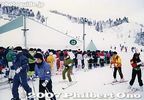
The line gets very long during the morning, so I usually go later in the day and ski until night when it is much less crowded. I catch the last shinkansen back to Tokyo.
|
|

It's not a large or long run, but better than nothing.
|
|

The quality of the snow is not as good as in Hokkaido, but better than nothing.
|
|
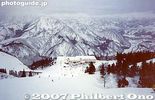
View from the top.
|
|
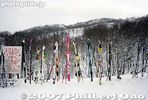
Skis left outside as their owners have lunch. It's nice that no one steals your skis.
|
|

On the mountain top is Biwako Hakodateyama ski grounds near Imazu. びわこ箱館山
|
|
|

Approaching Imazu in winter.
|
|
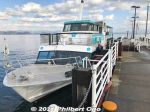
Interlaken at Imazu Port.
|
|
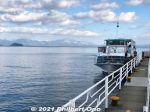
Imazu Port with Chikubushima and Mt. Ibuki in the background.
|
|

Clark Chapel on the left, and on the right is the Sapporo Snow Festival Museum which opened in 2001. It used to be a wedding chapel. さっぽろ雪まつり資料館
|
|

The Sapporo Snow Festival Museum has display panels of all the past Sapporo Snow Festivals, dating from 1950.
|
|

Panel for the 33rd Sapporo Snow Festival in 1982 which featured Iolani Palace of Honolulu, Hawaii.
|
|

Snow Festival poster
|
|

The museum also has rooms showing scale models of the giant snow sculptures built in the past. These scale models were made when the respective snow sculpture was being designed.
|
|

Scale model of Hawaii's Iolani Palace made of wood, painted white. Built for the 33rd Sapporo Snow Festival in 1982.
|
|

Scale model of the Iolani Palace made of wood, painted white. Built for the 33rd Sapporo Snow Festival in 1982. The palace is in Honolulu, Hawaii, built by King David Kalakaua in 1882.
|
|

Top view of Iolani Palace scale model.
|
|
|

Sculpture of Commodore Perry's visit to Japan (2003).
|
|

More scale models in this room.
|
|

Horyuji temple, Nara
|
|

Palace in Thailand (2007)
|
|

Left is the capitol building in Norway (2005), and on the right is Flinders Street Station in Australia (2006).
|
|

Concert Gebouw, Holland (2000)
|
|

Salzburg Cathedral, Austria (1996)
|
|

Munich National Museum, Germany (1997)
|
|

London St. Paul's Cathedral, UK (1998)
|
|

Schloss Linderhof castle, Germany (1995)
|
|

Tools used to carve the snow sculptures.
|
|

Sapporo Snow Festival memorabalia.
|
|

Sapporo Snow Festival pins
|
|

Sapporo Snow Festival postcards
|
|

Snow Festival book
|
|
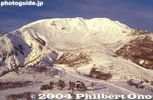
Snow on Mt. Ibuki at the 3rd station, the main area for skiing (when there is snow).
|
|

Skiing on Mt. Ibuki at the 3rd station. How it looked in the good old days.
|
|
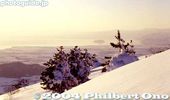
Snow on Mt. Ibuki and Lake Biwa as seen from the ski lift to the 3rd station.
|
|

Sunset on snowy Mt. Ibuki in winter at the 2nd station.
|
|

A frozen Mishima Pond (Mishima-Ike) and Mt. Ibuki in winter. The pond is small, but quite picturesque with Mt. Ibuki in the background. MAP
|
|

The oblong pond's circumference is about 780 meters. It was first created about 700 years ago as a water reservoir for agriculture. It is also a bird sanctuary.
|
|

The pond is quite shallow, about 50 cm. It is one favorite destination for migratory birds including the Mallard duck. It is next to Mishima Shrine.
|
|

Mt. Ibuki and Mishima Pond, Maibara, Shiga Pref.
|
|

Mishima Pond is adjacent to the Green Park Santo recreational park. The nearest train station is Omi-Nagaoks on the JR Tokaido Line. Take a bus.
|
|
|
|
|

Where the frozen surface meets the non-frozen part.
|
|

Mishima Pond during a warmer winter
|
|
|
|
|
|

Rock engraved with "Mishima Pond" in Japanese. 三島池
|
|

Bridge in the middle of the pond leading to a stone lantern.
|
|
|
|
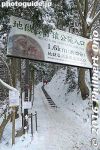
The world-famous, hot spring-loving snow monkeys in Yamanouchi, Nagano Prefecture must be Japan's most photographed wild animals. "The only place in the world where monkeys bathe in hot springs."They live in the mountains in a valley named Jigokudani (Hell Valley). A snow monkey park (Jigokudani Yaen Koen) was established for them in 1964 where the park operator feeds the monkeys and maintains a hot spring (onsen) bath for them. Although winter (with snow) is the most popular time to see the monkeys, the park is open year round (9 am–4 pm).
This is the entrance to the trail to the snow monkey park in Yamanouchi town, Nagano Prefecture. It's about 1.6 km or a 30-min. walk (longer if you stop and take pictures).
|
|
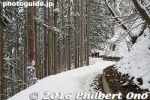
The trail is nice and flat, but can be snowy/icy and slippery. It's a nice and easy walk along the forest. In winter, you definitely need to be dressed warmly. The temperature was freezing when we visited in mid-Jan. 2016.The nearest train station is Yudanaka Station, little over an hour by Nagano Electric Railway train from Nagano Station. From Yudanaka Station, it's about 15 min. by car/taxi to the park entrance. A day trip from Tokyo is possible, but I highly recommend staying overnight at a nearby onsen (hot spring).
|
|
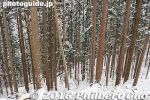
A thick jacket, ski cap covering your ears, gloves, thick socks, and hiking shoes are a must (no high heels, sneakers, dress shoes, etc.). Hand warmers (kairo) are good too. The entrance has a souvenir shop where you can rent winter clothing.
|
|
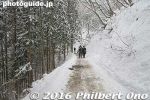
Japanese snow monkeys (macaque) live in the Shiga Kogen Highland area in the Nagano mountains. They have developed a custom of dipping in a hot spring built especially for them.
|
|

The trail also has these informative signs explaining about the monkeys. Also helpful to know how far you have walked and how much more to go.
|
|
|
|
|
|
|
|
|
|
|
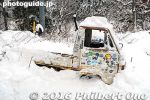
I'm told that this old truck has been abandoned here for many years. It has become a landmark at the end of the trail.
|
|
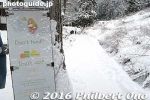
After walking 30 min. or so, signs of civilization. "Don't feed the monkeys and don't eat in front of the monkeys."
|
|
|

The Jigokudani Yaen Koen snow monkey park, where the snow monkeys live, is part of the Joshin-etsu Kogen National Park in Shiga Kogen Highland.
|
|
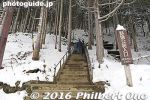
Go up these steps to the park admission gate.
|
|
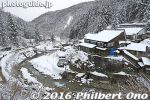
Jigokudani Onsen spa is near the snow monkey park. This ryokan named Korakukan has baths for humans and monkeys.
|
|
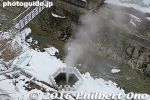
Jigokudani (Hell Valley) is a common name in Japan for valleys that have volcanic steam vents and other hot stuff. (Japan's image of hell is "hot.") However, this was the only steaming vent I saw in the valley.
|
|

Park rules
|
|
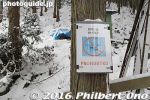
No drones
|
|
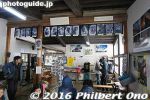
Near the monkey's onsen bath is this hut where you can take a break or warm up before heading back. It's literally a lifesaver. Wish they at least had a foot bath too.
|
|
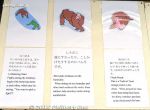
The hut has these informative sheets about the snow monkeys.
|
|
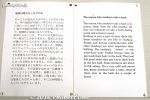
Why snow monkeys bathe in the hot spring.
|
|
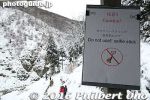
No selfie sticks.
|
|
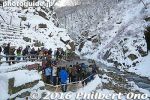
Walk all the way toward the back of the valley, pay the ¥500 park admission, and you'll see this. Tourists crowd around the onsen bath made especially for the snow monkeys.In a beautiful location next to the river. Just the day before, there was little snow here.
|
|
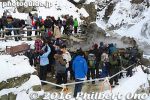
This is the only onsen bath where the monkeys bathe. All the photos of bathing snow monkeys you have seen were taken here. But not all monkeys bathe here. Only some of them bathe.The place is most crowded with tourists in the morning and lunch time. Most are foreign tourists, some Chinese too. Few Japanese tourists. The snow monkeys are more famous outside Japan than in Japan.
|
|

Humans don't bathe in here. The monkeys poop in the water so you may see poop floating around. No smell though.
|
|

Baby monkey. From generation to generation, these monkeys develop and pass down their habit of bathing in this hot spring.
|
|
|
|

Snow monkeys taking a bath and showing relaxed faces.
|
|

It's not unusual to see wild monkeys in Japan. So to the Japanese, these monkeys are not exotic nor unusual, even if they are bathing in an onsen.
|
|

Although monkeys appear in Japanese legends/folktales and may even serve as a divine messenger for certain Shinto gods, monkeys are generally viewed with disdain in Japan.
|
|
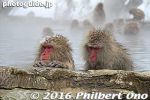
They steal food from souvenir shops, they can attack you for your bag of food, and they may hangout along the road for handouts from drivers.
|
|

My favorite shot. I'm not sure if he's exhibiting a derogatory gesture to us humans. The calluses on the buttocks serve as a cushion for sitting. It seems that they don't have the cushy/fatty buttocks that we do, so they need to grow calluses instead.
|
|

These monkeys are obviously accustomed to humans and they seem quite tame and well-behaved. As long as you keep your distance and don't disturb them or eat something in front of them.
|
|
|
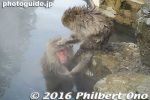
The monkeys always go comb through each other's fur for lice.
|
|
|
|
|

Baby monkeys have no fear of humans.
|
|
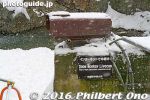
Next to the monkey spa is a live cam which you can see online here. You can see the monkeys bathing during the day and see how much snow there is.If you visit the snow monkeys, you can tell your friends to watch you on the live cam (updated every minute).
http://www.jigokudani-yaenkoen.co.jp/livecam/monkey/index.htm
|
|
|

Park staff throwing grain on the ground to feed the monkeys along the river.
|
|
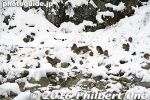
Lunch time for the monkeys.
|
|

Immediately down river from the monkey spa, more monkeys roam and hangout.
|
|
|
|
|
|
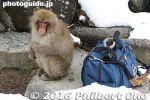
Monkey totally ignored this bag.
|
|
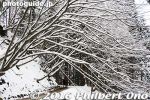
I must say that having snow is the key here. Without it, it wouldn't be worth the trouble of coming here.More info about the snow monkey park: http://en.jigokudani-yaenkoen.co.jp/about
|
|
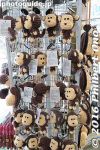
Monkey souvenirs at the gift shop at the trail's entrance.
|
|
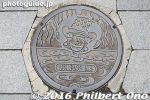
Manhole in Shibu Onsen showing a snow monkey in a bath. Shibu Onsen is near the entrance to the trail to the monkey park.
|
|

The following photos were taken by photographers from New Brunswick, Canada during a photo trip to Japan in March 2005. Led and guided by pro photographer Mark Hemmings, they were Kevin Halcrow, Jeff and Kim Matheson, and Ashley Hicks.
|
|

Snow monkeys
|
|

Ahhh...
|
|
|
|
|
|
|
|
|
|
|
|

Wet monkey
|
|
|
|
|
|
|
|
|
|
|
|
|
|
|

Sapporo Snow Festival in Sapporo, Hokkaido is held for about a week in early Feb. These are photos of the 61st Sapporo Snow Festival held during Feb. 5-11, 2010. The main festival site is at Odori Park anchored on the east end by Sapporo TV Tower. I started exploring this site from here.
|
|

Odori Park is a long, rectangular park divided into numbered blocks called "chome." Next to the TV tower was 1-chome with a skating rink (free of charge) and 2-chome featuring a group of sculptures called Winter Sports Kingdom Hokkaido!
|
|

These blocks of ice lighted in red have carved reliefs of various winter sports. I was in Sapporo for three days and visited the festival sites every day, during the day and evening.
|
|

Figure skater. The weather was mostly cloudy with occasional light snowfall during most of the festival week. The temperature was around freezing, so wearing a ski cap or jacket hood kept my ears warm.
|
|

The main sculpture in 2-chome. "Winter Sports Kingdom Hokkaido!"
|
|

Ice figures of winter sports athletes. When the freezing wind blows, your unprotected ears will feel it first. But in Sapporo, warm shelter is always nearby, either below ground or in a building.
|
|

Beautiful at night as well. The snow festival sculptures are lit up until 10 pm nightly during the festival. It's too cold to keep standing to watch something for more than 20 min. It's best to keep moving.
|
|

They had a Yamaha keyboard player providing music coordinated with the colorful lighting. 2丁目 ウィンタースポーツ王国・北海道
|
|

In the next block at 3-chome was the Snowboard Jump hill standing 24 meters high and 65 meters long. They held snowboard jump tournaments during the snow festival. Free to watch.
|
|

Female snowboard jumper
|
|

Also ski jumpers. 3丁目 スノーボードジャンプ台
|
|

Back of the snowboard jump hill.
|
|

In 4-chome was the first giant snow sculpture called "Zoo of the Northland" in STV/Yomiuri Square.
|
|

With a very impressive carving of animals, this was clearly the crowd favorite. "Zoo of the Northland" features endangered animals at the 61st Sapporo Snow Festival.
|
|
|

Gorilla
|
|

Bear and cubs
|
|
|

Steller's sea eagle オオワシ
|
|

Wolves
|
|

Snow leopard, very impressive.
|
|

Penguins
|
|

Stage event
|
|
|
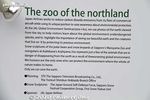
About the "Zoo of the Northland" in English.
|
|

At a few of the big sculptures, they offered to take a picture of you in front of the sculpture with your camera. At the same time, they offered to sell you a picture they took with their camera.
|
|

People taking advantage of the picture-taking service in front of the Northland animals.
|
|

A cutie poses with a fake salmon in front of the Northland sculpture.
|
|

"Zoo of the Northland" sculpture lit up at night.
|
|

Snow leopard at night.
|
|
|
|
|
|

Back of the "Zoo of the Northland" sculpture.
|
|

Booth for Poland.
|
|

Smoking was prohibited while walking at the festival site, so these smoking stations were provided.
|
|

At 5-chome was "Place Where Dreams Come True" featuring sculpture of Mickey and Minnie Mouse and Cinderella's Castle. Disney is popular in Japan.
|
|

Mickey and Minnie Mouse
|
|

Entertainment held here included a talent contest for young wannabe idols.
|
|

Mickey and Minnie lit up at night.
|
|

Facing Mickey and Minnie Mouse was this PR booth by a soft drink maker. Inside was a display of Uemura Aiko's ski wear and skis.
|
|

Display of Uemura Aiko's ski wear and skis used in previous seasons. Uemura is a freestyle mogul skier who is competing in the Vancouver Winter Olympics.
|
|

Candle lights
|
|

Smaller snow sculptures made by companies and organizations also dot the festival site.
|
|
|
|

An impressive snow sculpture of Michael Jackson drew crowds.
|
|

Michael Jackson snow sculpture at the 2010 Sapporo Snow Festival. Coiled wiring is used for the hair dangling below his hat.
|
|

Michael Jackson snow sculpture
|
|

Also in 5-chome was the snow festival's largest ice sculpture: Iolani Palace, Hawaii's most famous building and built in 1882 by King David Kalakaua as the royal residence.
|
|

Iolani Palace, a giant ice sculpture at the 61st Sapporo Snow Festival during Feb. 5-11, 2010. During the day, it has a translucent, blue look. This block is officially called the Mainichi Shimbun Ice Square
|
|

A flag-raising game held in front of the ice sculpture. The Iolani Palace ice sculpture is 16 meters wide and 8 meters high. It was built with 700 large blocks of ice weighing 135 kg (298 lb.) each.
|
|

The Iolani Palace ice sculpture was especially beautiful at night, lit up with colorful lights. It was built by over 250 members of the Japan Ice Sculpture Association, most of whom were chefs working at Sapporo hotels.
|
|
|
|
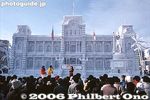
It was not the first time Iolani Palace was built at the Sapporo Snow Festival. In Feb. 1982, it was built of snow as one of the largest sculptures.
|
|
|

Crossing the road to 6-chome. 6丁目
|
|

6-chome had this medium-size snow sculpture called Seitokai no Ichizon. 生徒会の一存
|
|

6-chome also had the festival site's largest food court called, "Hokkaido Winter Food Park." There was also a large TV monitor showing how the snow sculptures were designed and constructed.
|
|

Food stall staff shouted to attract customers' attention.
|
|

Tora-san in an ecological car. (Tora means tiger, and 2010 is the Year of the Tiger.)
|
|

Sign for 7-chome.
|
|

Entering 7-chome which was the HBC (Hokkaido Broadcasting Co.) German Square. 7丁目 HBCドイツ広場
|
|

Medium-size snow sculpture of Germany's Wartburg Castle. ヴァルトブルク城
|
|

German Square's main snow sculpture was this Dresdner Frauenkirche, a Lutheran Church in Dresden, Germany. フラウエン教会
|
|

Dresdner Frauenkirche means "Church of Our Lady."
|
|
|
|

About Dresdner Frauenkirche in English.
|
|

Dresdner Frauenkirche snow sculpture lit up at night.
|
|

TV event in front of Dresdner Frauenkirche.
|
|

Back of Dresdner Frauenkirche.
|
|

Next at 8-chome was the Baekje Royal Palace of Korea. The sculpture is 25 meters wide and 18 meters high. Apparently it was built on the occasion of the Great Baekje World Festival to be held during Sept.-Oct. 2010.
|
|

Baekje was one of the Three Kingdoms of Korea. 8丁目 韓国・百済
|
|
|

On-chan
|
|
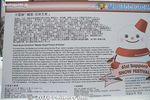
About the Baekje Royal Palace in English.
|
|

Side view of Baekje Royal Palace snow sculpture.
|
|

Rear view of Baekje Royal Palace snow sculpture.
|
|

Scale model of Baekje Royal Palace snow sculpture.
|
|

Night view of Baekje Royal Palace snow sculpture.
|
|
|
|

Night view of Baekje Royal Palace snow sculpture.
|
|

Night view of Baekje Royal Palace snow sculpture.
|
|

A food court faced the Baekje Royal Palace snow sculpture.
|
|

In 9-chome was this medium-size snow sculpture of Hokkaido University's Agricultural Dept. 9丁目 北海道大学農学部棟
|
|

Hokkaido Nippon Ham Fighters pro baseball team is based in Sapporo. This sculpture depicts their victory parade.
|
|

Smaller snow sculptures dot 9-chome.
|
|

Ultraman by Navy Misawa in Aomori.
|
|

Castle in Noda, Chiba.
|
|

Sento-kun, official mascot for Nara's 1200th anniversary. Not a good likeness, but acceptable.
|
|

Mother helping son to study.
|
|

Playing with grandpa.
|
|

Hatsune Miku was much photographed. 初音ミク
|
|

Strange English on sign.
|
|

Dirt sprinked on the snowy and icy paths gives your shoes better grip. It is very easy to slip and fall while walking on Sapporo's icy roads and sidewalks.
|
|

Ice slide at 10-chome called "Familyland."
|
|

Ice slides for kids.
|
|
|

Mini train was popular. Notice the long line in the background.
|
|

The last giant snow sculpture at Odori Park was at 10-chome. It was the famous Chibi Maruko-chan.
|
|

10丁目 ちびまる子ちゃん
|
|

Chibi Maruko-chan snow sculpture.
|
|

Chibi Maruko-chan classmates
|
|
|

Chibi Maruko-chan
|
|

Chibi Maruko-chan at night.
|
|

The Chibi Maruko-chan snow sculpture marked the 20th anniversary of the cartoon's TV broadcast.
|
|

Too tall to be Chibi Maruko-chan.
|
|

Rear of Chibi Maruko-chan snow statue.
|
|

Here and there at the Odori Park site, freebies were give away. This line was for miso paste.
|
|

This booth gave away hot matcha green tea.
|
|
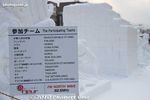
At 11-chome, the International Square featured small snow sculptures made by international teams. As listed on this sign, fourteen national teams participated in 2010.
|
|

Snow sculpture by Singapore
|
|

Taniwha by New Zealand
|
|

Hanoman Duta by Indonesia
|
|

The Gift, by the Netherlands.
|
|

Kraithong by Thailand
|
|

Kraithong by Thailand showing an alligator killer.
|
|

Freyderyk Chopin by Poland
|
|

Honu "flying" turtles by the Hawaii team.
|
|
|
|